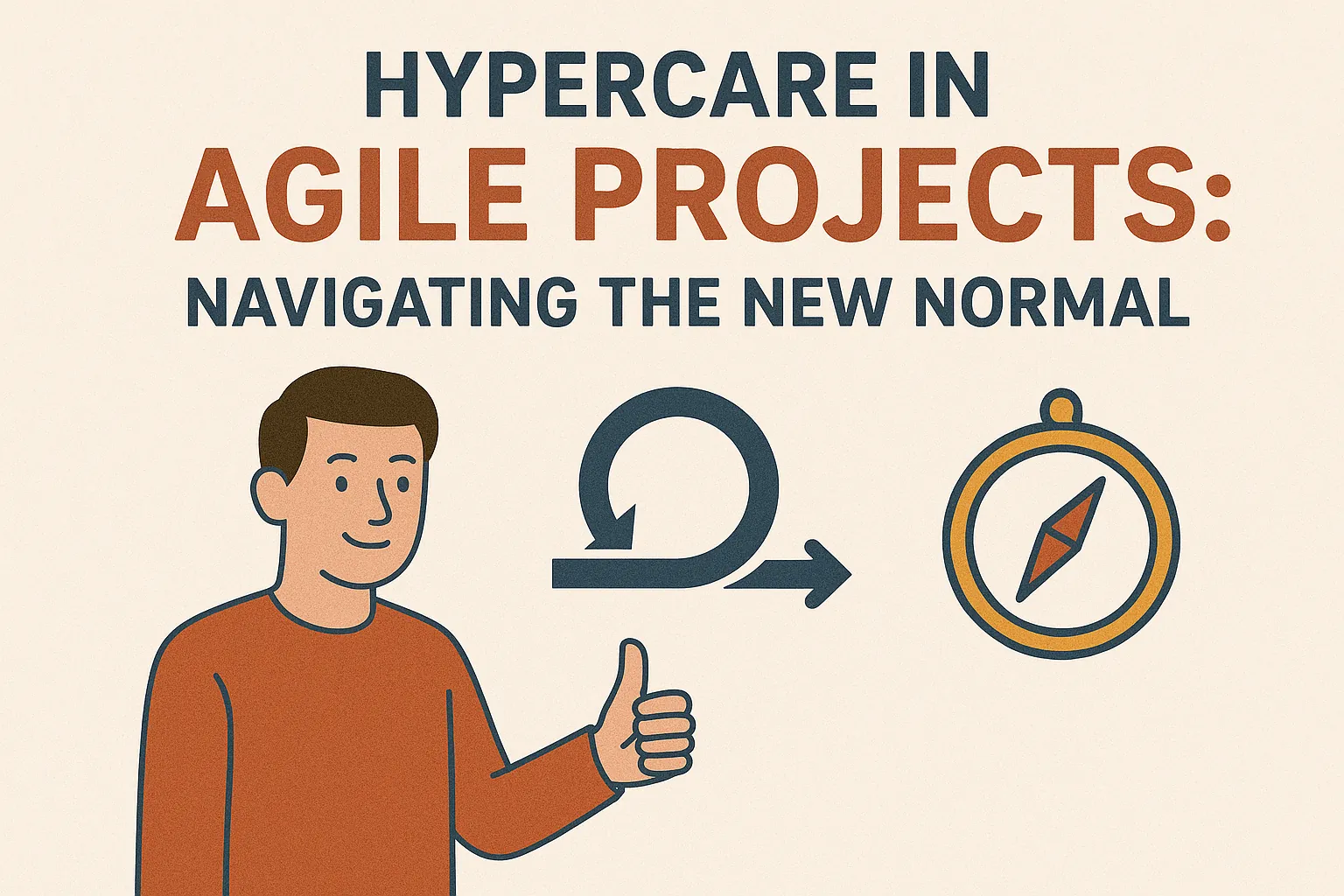Introduction to Hypercare in Agile Projects
Particularly within agile frameworks, the concept of hypercare has emerged as a critical component for ensuring project success post-implementation. Hypercare refers to the heightened level of support provided immediately following the launch of a project or system, aimed at addressing any issues that may arise and ensuring stability. This phase is essential for mitigating risks and enhancing user satisfaction, especially in environments where rapid changes and iterations are the norm.
Definition of Hypercare and Its Importance in Project Management
Hypercare is characterized by an intensive support period that follows the go-live of a project. During this time, project teams focus on diagnosing and resolving any post-implementation issues swiftly. The importance of hypercare in project management cannot be overstated, as it serves to:
- Enhance System Stability: By providing immediate support, hypercare helps to stabilize new systems and processes, ensuring they function as intended from the outset [5].
- Reduce Risk of Churn: In industries where customer retention is critical, hypercare can significantly lower the risk of churn by addressing user concerns promptly and effectively [6].
- Facilitate Continuous Improvement: The feedback gathered during the hypercare phase can inform future iterations and improvements, aligning with agile principles of adaptability and responsiveness [3].
Overview of Agile Project Management Principles
Agile project management is built on a set of principles that prioritize flexibility, collaboration, and customer-centricity. Key principles include:
- Iterative Development: Agile projects are executed in short cycles, known as sprints, allowing teams to adapt to changes quickly and deliver incremental value [4].
- Customer Collaboration: Agile emphasizes ongoing communication with stakeholders to ensure that the project meets their needs and expectations.
- Embracing Change: Agile methodologies encourage teams to welcome changes, even late in the development process, to enhance the final product’s quality.
The Intersection of Hypercare and Agile Methodologies
The integration of hypercare within agile project management creates a robust framework for addressing the unique challenges that arise during and after project implementation. This intersection is marked by several key aspects:
- Proactive Support: Agile teams can leverage hypercare to provide proactive support, ensuring that any issues are identified and resolved before they escalate [1].
- Defined Duration: Hypercare typically has a defined duration, often lasting around three months, which aligns well with agile sprints and allows for focused attention on post-launch challenges [9].
- Single Point of Contact: Establishing a single point of contact during hypercare can streamline communication and enhance the support experience for clients, ensuring that their needs are met efficiently [8].
Understanding Hypercare: What It Is and Why It Matters
Hypercare is a critical phase in project management, particularly within agile frameworks, that focuses on providing heightened support immediately following the implementation of a new system or solution. This phase is essential for ensuring that any post-launch issues are promptly addressed, thereby stabilizing the system and enhancing user satisfaction. Here’s a detailed exploration of hypercare, its benefits, and the challenges that may arise during this period.
Detailed Explanation of Hypercare Phases
Hypercare typically encompasses several key phases:
- Preparation: Before the go-live date, teams should prepare for hypercare by establishing a support structure, defining roles, and ensuring that all necessary resources are in place. This includes training support staff and creating documentation for common issues.
- Go-Live Support: This phase involves providing immediate assistance as users begin to interact with the new system. It is crucial to have a dedicated support team ready to address any issues that arise, ensuring that users feel supported and confident in using the new solution [3][5].
- Monitoring and Issue Resolution: During this period, the focus shifts to monitoring system performance and user feedback. The support team should be proactive in identifying and resolving issues, which may involve troubleshooting, providing additional training, or making necessary adjustments to the system [1][5].
- Transition to Steady State: As the system stabilizes and users become more comfortable, the hypercare phase gradually transitions to a regular support model. This involves evaluating the effectiveness of the hypercare efforts and making adjustments as needed to ensure ongoing support [9].
Benefits of Implementing Hypercare in Projects
Implementing a hypercare strategy offers several advantages:
- Enhanced User Experience: By providing immediate support, hypercare helps to minimize disruptions and enhances the overall user experience. This is particularly important in agile projects where user feedback is integral to ongoing development [6].
- Increased System Stability: Hypercare allows for rapid identification and resolution of issues, which contributes to the overall stability of the system. This is crucial in preventing potential churn among users who may be frustrated by unresolved problems [6][5].
- Improved Team Collaboration: The hypercare phase encourages collaboration between project teams and support staff, fostering a culture of communication and teamwork that can lead to better outcomes in future projects [2][9].
Common Challenges Faced During Hypercare Periods
Despite its benefits, the hypercare phase can present several challenges:
- Resource Allocation: Ensuring that adequate resources are available for hypercare can be difficult, especially in organizations with limited support staff. This can lead to delays in issue resolution and increased user frustration [1][6].
- Managing User Expectations: Users may have high expectations for immediate support and resolution of issues. If these expectations are not managed effectively, it can lead to dissatisfaction and a perception that the project has not met its goals [2][5].
- Transitioning to Regular Support: Moving from hypercare to a steady state can be challenging, as it requires careful planning and communication to ensure that users continue to receive the support they need without the heightened focus of the hypercare phase [9][3].
The Role of Agile Methodologies in Hypercare Implementation
The concept of hypercare has emerged as a critical component for ensuring project success post-implementation. Hypercare refers to the heightened support and monitoring provided immediately after a project goes live, aimed at addressing any issues that arise and ensuring a smooth transition. Here’s how agile methodologies influence hypercare strategies:
Agile Principles that Align with Hypercare
- Customer Collaboration: Agile methodologies emphasize the importance of engaging with customers throughout the project lifecycle. This principle aligns seamlessly with hypercare, as ongoing communication with stakeholders during the hypercare phase allows for immediate feedback and adjustments based on user experiences and needs. By fostering a collaborative environment, project teams can quickly address concerns and enhance user satisfaction [2].
- Responsiveness: Agile frameworks prioritize adaptability and responsiveness to change. This is particularly beneficial during hypercare, where the ability to pivot and respond to unforeseen challenges is crucial. Agile teams can leverage their iterative approach to implement quick fixes and enhancements based on real-time data and user feedback, ensuring that the project remains aligned with stakeholder expectations [6].
Impact of Iterative Cycles and Sprints on Hypercare Efforts
- Continuous Improvement: The iterative nature of agile methodologies allows for ongoing assessment and refinement of processes. During hypercare, teams can utilize short sprints to focus on specific issues, implement solutions, and evaluate their effectiveness. This cycle of continuous improvement not only resolves immediate problems but also contributes to the overall enhancement of the project [6].
- Frequent Check-ins: Agile practices encourage regular check-ins and status updates, which are vital during the hypercare phase. Weekly project status meetings can facilitate communication between project teams and stakeholders, ensuring that everyone is informed about progress and any emerging issues. This proactive approach helps in maintaining momentum and addressing concerns before they escalate [8].
Case Studies of Successful Hypercare within Agile Frameworks
- Case Study 1: ERP Implementation: A company implementing an ERP system adopted agile methodologies to manage their hypercare phase. By conducting iterative sprints focused on user feedback, they were able to quickly resolve issues related to system usability. This approach not only improved user satisfaction but also reduced the time required for full system adoption [7].
- Case Study 2: Software Development: Another organization utilized agile principles during their hypercare phase after launching a new software product. They established a dedicated hypercare team that operated in short cycles, allowing them to address bugs and user concerns rapidly. This strategy led to a significant decrease in support tickets and an increase in user engagement within the first month post-launch [6].
Key Hypercare Strategies for Agile Project Managers
In the fast-paced environment of agile project management, the implementation of hypercare strategies is essential for ensuring a smooth transition from project deployment to operational use. Hypercare, a concentrated support phase following the launch of a project, is crucial for addressing any issues that may arise and ensuring system stability. Here are some actionable strategies for agile project managers to effectively implement hypercare within their frameworks:
1. Establishing Clear Communication Channels
Effective communication is the backbone of successful hypercare. Agile project managers should:
- Define Communication Protocols: Establish clear guidelines on how team members, stakeholders, and users can report issues or seek assistance. This could include dedicated channels on collaboration tools or regular check-in meetings.
- Utilize Real-Time Communication Tools: Leverage platforms like Slack or Microsoft Teams to facilitate immediate communication, ensuring that any issues are addressed promptly and efficiently [5][8].
2. Setting Up Monitoring and Feedback Loops
Continuous monitoring and feedback are vital during the hypercare phase. Agile project managers can:
- Implement Performance Metrics: Track key performance indicators (KPIs) to assess the system’s stability and user satisfaction. This data can help identify areas needing immediate attention [2][11].
- Create Feedback Mechanisms: Establish regular feedback sessions with users to gather insights on their experiences and any challenges they face. This can be done through surveys or direct interviews, allowing for quick adjustments to be made [12][14].
3. Role of Cross-Functional Teams in Hypercare
Cross-functional collaboration is essential in agile environments. Agile project managers should:
- Form Dedicated Hypercare Teams: Assemble a team comprising members from various functions (development, operations, support) to ensure a holistic approach to issue resolution. This diversity can lead to innovative solutions and faster problem-solving [10][15].
- Encourage Knowledge Sharing: Foster an environment where team members share insights and experiences from their respective areas, enhancing the overall effectiveness of the hypercare phase [11][14].
4. Documentation and Knowledge Transfer Best Practices
Proper documentation and knowledge transfer are critical for sustaining project success. Agile project managers can:
- Maintain Comprehensive Documentation: Ensure that all processes, issues, and resolutions are documented thoroughly. This documentation serves as a valuable resource for future projects and for onboarding new team members [9][12].
- Facilitate Knowledge Transfer Sessions: Organize workshops or training sessions to share lessons learned and best practices from the hypercare phase with the broader team. This not only aids in immediate problem-solving but also prepares the team for future projects [10][13].
By implementing these hypercare strategies, agile project managers can navigate the complexities of project deployment more effectively, ensuring that their teams are well-prepared to address challenges and maintain system stability. This proactive approach not only enhances user satisfaction but also contributes to the long-term success of agile projects.
Navigating Challenges During Hypercare in Agile Projects
The hypercare phase in agile project management is critical for ensuring a smooth transition from development to operational stability. However, it is not without its challenges. Agile project managers must be prepared to navigate potential pitfalls that can arise during this period. Here are some common challenges, techniques for overcoming them, and the importance of proactive risk management.
Common Challenges
- Scope Creep: One of the most prevalent issues during hypercare is scope creep, where additional features or changes are requested after the project has gone live. This can lead to confusion and resource strain, diverting attention from critical support tasks.
- Resistance to Change: Team members and stakeholders may resist new processes or systems introduced during the hypercare phase. This resistance can hinder the adoption of the new solution and affect overall project success.
- Communication Gaps: Effective communication is essential during hypercare. Miscommunication can lead to misunderstandings about roles, responsibilities, and expectations, which can exacerbate existing issues.
- Insufficient Support Resources: Agile teams may not have adequate resources or support structures in place to address issues promptly, leading to delays in problem resolution and user dissatisfaction.
Techniques for Overcoming Challenges
- Establish Clear Processes: Implement well-defined processes for issue tracking, escalation paths, and communication. This clarity helps manage expectations and ensures that all team members are aligned on their roles during hypercare [3][10].
- Create a War Room: Setting up a centralized support base of operations can facilitate quick decision-making and issue resolution. This “War Room” approach allows for real-time collaboration and problem-solving among team members [9].
- Engage Stakeholders Early: Involve stakeholders in the hypercare planning process to address potential resistance to change. By soliciting their input and keeping them informed, you can foster a sense of ownership and reduce pushback [2][8].
- Proactive Communication Strategy: Develop a robust communication strategy that includes regular updates and feedback loops. This ensures that all team members and stakeholders are aware of ongoing issues and resolutions, minimizing confusion [2][4].
Importance of Proactive Risk Management
Proactive risk management is crucial during the hypercare phase. By identifying potential risks early, agile project managers can implement strategies to mitigate them before they escalate into significant issues. This includes:
- Regular Risk Assessments: Conducting frequent assessments to identify new risks as they arise and adjusting strategies accordingly [8].
- Training and Support: Providing adequate training and resources to team members can help them adapt to new systems and processes, reducing resistance and improving overall project outcomes [5][7].
- Feedback Mechanisms: Establishing channels for feedback allows teams to learn from experiences and continuously improve their hypercare strategies, ensuring that they are better prepared for future projects [4][6].
Measuring Success in Hypercare: Metrics and KPIs
Hypercare represents a critical phase that ensures a smooth transition from project delivery to operational stability. As agile project managers navigate this new normal, it becomes essential to define success in hypercare and establish effective metrics and KPIs to assess its effectiveness. Here are key points to consider:
Defining Success in the Context of Hypercare
Success in hypercare can be defined through several dimensions, including:
- Stability of the New Solution: Assessing whether the implemented solution operates without significant issues is paramount. This includes monitoring the number of incidents reported and the resolution time for these incidents, which can indicate the overall stability of the solution [2][10].
- User Adoption Rates: Understanding how well users are adapting to the new system is crucial. High user adoption rates often correlate with successful hypercare efforts, as they reflect the effectiveness of training and support provided during this phase [9][14].
- Achievement of Defined Success Criteria: Establishing clear success criteria at the project initiation phase allows project managers to measure hypercare effectiveness against these predefined benchmarks [10].
Key Performance Indicators (KPIs) for Monitoring Hypercare Outcomes
To effectively monitor hypercare outcomes, agile project managers should consider the following KPIs:
- Incident Management Metrics: This includes tracking the number of incidents, their severity, and the average resolution time. A decrease in incidents over time can indicate successful hypercare management [1][11].
- Turnaround Time for Support Requests: Measuring how quickly support requests are addressed can provide insights into the responsiveness of the hypercare team. Short turnaround times are indicative of an effective support structure [6][14].
- Resource Utilization: Evaluating how effectively resources are being utilized during the hypercare phase can help identify areas for improvement. This includes assessing the workload of support staff and the efficiency of processes in place [6][15].
- User Satisfaction Scores: Gathering feedback from users through surveys can provide valuable insights into their experiences during hypercare. High satisfaction scores can reflect the success of the hypercare phase [13][15].
Feedback Mechanisms for Continuous Improvement
Continuous improvement is a cornerstone of agile methodologies, and hypercare is no exception. Implementing robust feedback mechanisms can enhance the effectiveness of hypercare strategies:
- Regular Check-ins and Reviews: Establishing a routine for check-ins with stakeholders and team members can facilitate open communication about challenges and successes during hypercare. This can help identify areas needing attention and foster a culture of collaboration [4][12].
- Post-Implementation Reviews: Conducting thorough reviews after the hypercare phase can provide insights into what worked well and what could be improved. This retrospective analysis is essential for refining future hypercare strategies [5][10].
- User Feedback Loops: Creating channels for users to provide ongoing feedback can help project managers make real-time adjustments to support and training efforts. This responsiveness can significantly enhance user experience and satisfaction [12][15].
Conclusion: Embracing Hypercare in the Agile Era
The concept of hypercare emerges as a vital component for ensuring project success and user satisfaction. As we have explored, hypercare is the intensive support provided immediately following a project launch, focusing on stabilizing the system and addressing any post-implementation issues swiftly. This phase is crucial for fostering a seamless transition from implementation to operational use, which is often fraught with challenges.
Key points discussed include:
- Immediate Support and Issue Resolution: Hypercare allows project teams to address issues promptly, ensuring that any bugs or operational hiccups are resolved quickly, which is essential in maintaining user trust and satisfaction [3][12].
- User Feedback and Continuous Improvement: Gathering user feedback during the hypercare phase is critical for ongoing improvement. This feedback loop not only helps in refining the project but also strengthens the relationship between the customer and the support organization [1][14].
- Defined Duration and Metrics for Success: Establishing a clear timeframe for hypercare, typically around three months, and measuring success through defined metrics ensures that the project team can transition smoothly into the next phases of the project lifecycle [2][5].
Find out more about Shaun Stoltz https://www.shaunstoltz.com/about/.
This post was written by an AI and reviewed/edited by a human.



